Difference Between Sigma Bond and Pi BondThe mechanism by which atoms combine to form molecules is known as chemical bonding. Atoms can share or transfer electrons with other atoms to create chemical bonds. The electronegativity of the atoms involved and the number of electrons they can share or transfer determine the type of bond created. 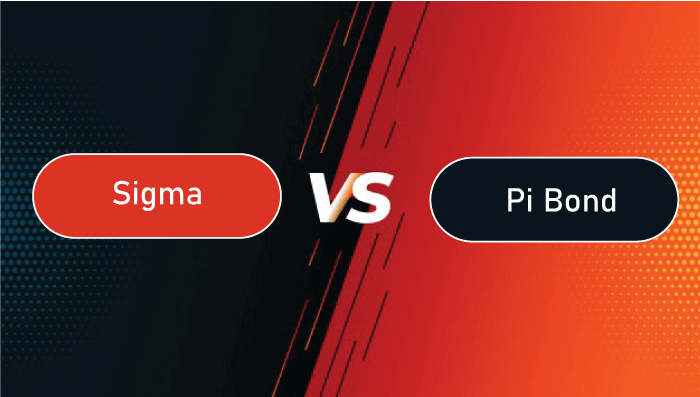
One of the most prevalent kinds of chemical bonding is covalent bonding, in which two atoms share an electron to create a bond. Sigma () bonds and pi () bonds are two different covalent interactions. These bonds have varying strengths and properties because the atoms share electrons. In organic chemistry and the study of molecule structures, it is crucial to comprehend the distinction between sigma and pi bonds. The Fundamentals of Covalent BondingAtoms share electrons to create a bond in a chemical bonding called covalent bonding. This kind of bonding usually takes place between atoms of non-metals. Atoms share one or more pairs of electrons in covalent bonds to attain a stable electron configuration. The number of shared electrons and the atom's electronegativity determine how strong a covalent connection is. An atom's capacity to draw electrons to itself is known as electronegativity. A nonpolar covalent bond is created when two atoms exchange electrons equally and have comparable electronegativities. A polar covalent bond is created when two atoms with different electronegativities share their electrons inequitably. Covalent bonds can also be categorized as single, double, or triple, depending on how many electron pairs are exchanged between the atoms. Three types of bonds share single, double, and triple electrons. Single bonds share one pair of electrons, double bonds share two pairs of electrons, and triple bonds share three. Covalent bonds must be formed for organic and other complex molecules found in nature to survive. Predicting these molecules' chemical and physical characteristics requires understanding of covalent bonding. Definition and Traits of Sigma BondsWhen two atomic orbitals cross over directly to exchange electrons between atoms, sigma bonds are created. The electron density is concentrated along the internuclear axis, creating a cylindrical shape that resembles the Greek letter sigma, which is why the bond is known as a sigma bond. The atoms are held together in a stable configuration by sigma bonds, usually the strongest covalent bonds in a molecule. They can be found in all different molecules, including complex organic compounds and diatomic molecules like H2. 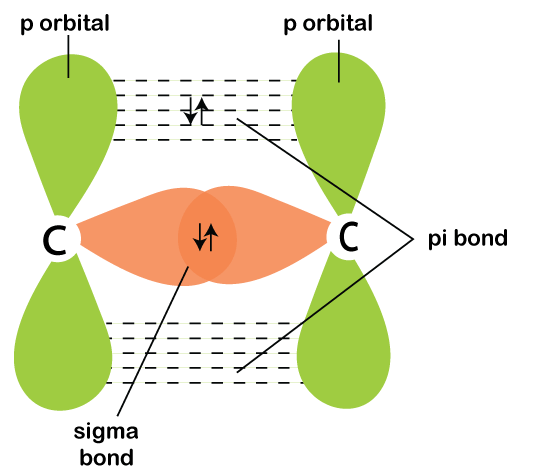
Between two s-orbitals, two p-orbitals, or an s and a p-orbital, sigma bonds can develop. The overlap of the atomic orbitals affects the strength of a sigma bond, with more overlap producing a stronger bond. In the hybridization process, in which atomic orbitals combine to create hybrid orbitals with various shapes and orientations, sigma bonds also play a significant part. Hybrid orbitals explain the chemical geometry and bonding in methane, ethylene, and acetylene molecules. The stability and structure of molecules depend on sigma bonds, a basic component of covalent bonding. Definition and Traits of Pi BondsPi bonds are created when two parallel atomic orbitals cross and exchange electrons between the atoms. Pi bonds are created by the horizontal overlap of atomic orbitals, as opposed to sigma bonds, created by the head-on overlap of atomic orbitals. Pi bonds are frequently used in double and triple bonds between atoms and are usually weaker than sigma bonds. They can be found in compounds like ethylene (C2H4), which has one sigma bond and one pi bond in its carbon-carbon double bond. 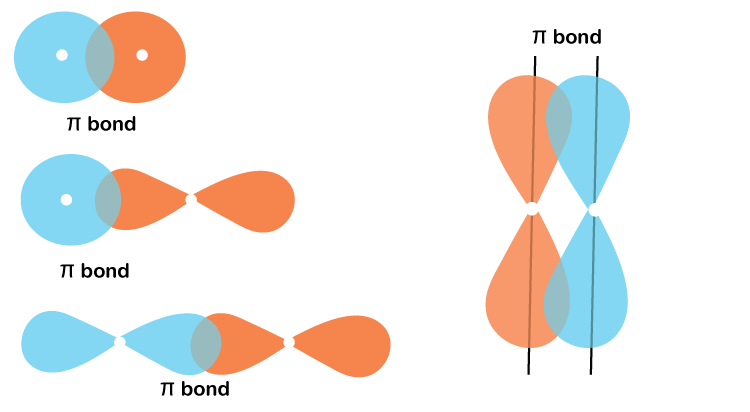
P-orbital or hybridized orbital contact forms pi bonds, which are always parallel to the internuclear axis. A dumbbell-shaped area of electron density is created by the overlapping orbitals above and below the internuclear axis. Pi bonds are important in the chemistry of organic substances and are necessary for the stability and characteristics of molecules. They participate in processes where pi bonds are broken to create new sigma bonds, such as addition reactions. In conclusion, pi bonds are essential to covalent bonding, giving compounds with double and triple bonds their distinct characteristics. Pi bonds are crucial to comprehend organic compounds' physical and chemical characteristics. Comparison of the Pi and Sigma BondsCovalent interactions of the sigma and pi varieties are crucial to molecules' composition and functionality. The following are some crucial variations between sigma and pi bonds: 1. Overlap While pi bonds are created by horizontal orbital overlap, sigma bonds are created by the head-on collision of atomic orbitals. 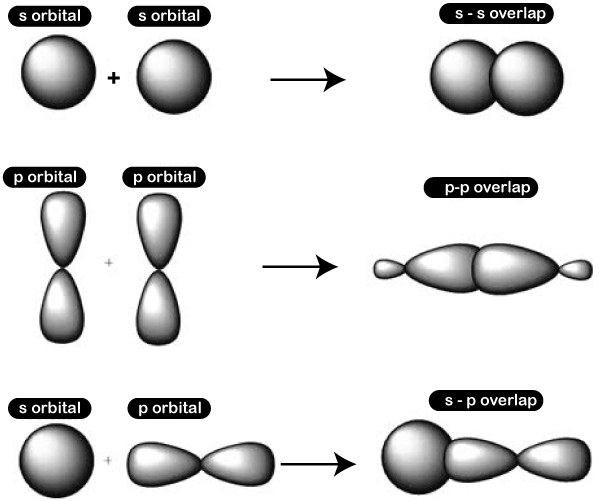
2. Orientation Pi bonds are always perpendicular to the internuclear plane, whereas sigma bonds are always oriented along it. 3. Electron Density Pi bonds have electron density above and below the internuclear axis, whereas sigma bonds have higher electron density along the internuclear axis. 4. Strength Due to a greater overlap of atomic orbitals, sigma bonds are usually stronger than pi bonds. 5. Number One sigma bond makes up a single bond, two sigma bonds and one pi bond make up a double bond, and three sigma bonds and two pi bonds make up a triple bond. 6. Involvement Pi bonds are usually present in molecules with double or triple bonds, whereas sigma bonds are always involved in covalent bonding. Overall, sigma bonds are stronger than pi bonds, are created by the head-on overlapping of atomic orbitals, and have a higher electron abundance along the internuclear axis. Pi bonds are usually found in molecules with double or triple bonds and are created by the lateral overlap of orbitals. They have an electron density above and below the internuclear axis. Bonding and the Theory of Molecular OrbitsMolecular orbital theory and bonding are important when discussing the distinction between sigma and pi bonds. According to the molecular orbital theory, molecules are atoms that share electrons to make molecular orbitals. Atomic orbitals meeting creates sigma and pi bonds. Sigma bonds are created when two atomic orbitals cross over directly, forming a cylinder with the highest electron density between the two nuclei. Due to their direct overlap, sigma bonds are stronger than pi bonds and permit free rotation around the bond plane. 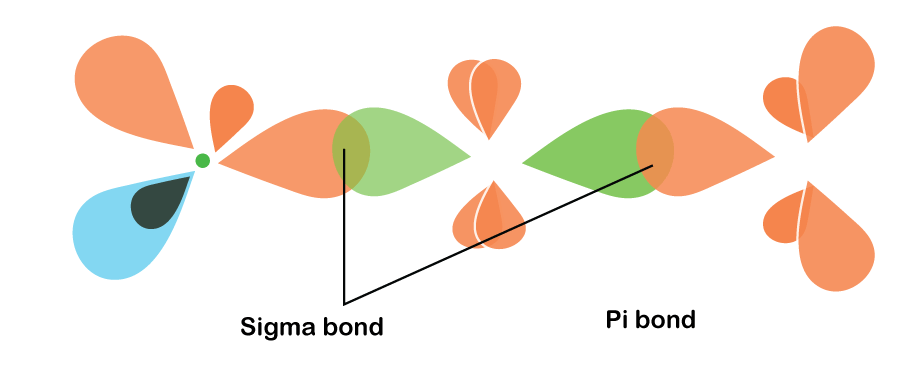
On the other hand, Pi bonds are made when two atomic orbitals cross sideways and create a region of maximum electron density above and below the bond axis, resembling a dumbbell. Due to their perpendicular overlap, pi bonds are weaker than sigma bonds and do not permit free rotation around the bond plane. The molecular orbital theory can be used further to describe the distinction between sigma and pi bonds. According to molecular orbital theory, sigma bonds are created when two atomic orbitals with the same energy and symmetry meet. Pi bonds are created when two atomic orbitals with various symmetry and energies cross over one another. One sigma bond and one pi bond are created when a double bond is established, and one sigma bond and two pi bonds are created when a triple bond is formed. The stability, reactivity, and electronic and geometrical shapes of molecules can all be predicted using the molecular orbital theory. Organic Molecule Examples of Sigma and Pi BondsSigma and pi bonds are essential in defining organic molecules' physical and chemical characteristics. Examples of sigma and pi bonds in organic molecules include the following:
The two carbon atoms in ethane, a straightforward hydrocarbon with the chemical formula C2H6, are joined by a single sigma bond created by the intersection of two sp3 hybridized atomic orbitals. Additionally, every carbon atom forms three sigma bonds with hydrogen atoms. These bonds are created when the sp3 hybridized atomic orbitals meet. 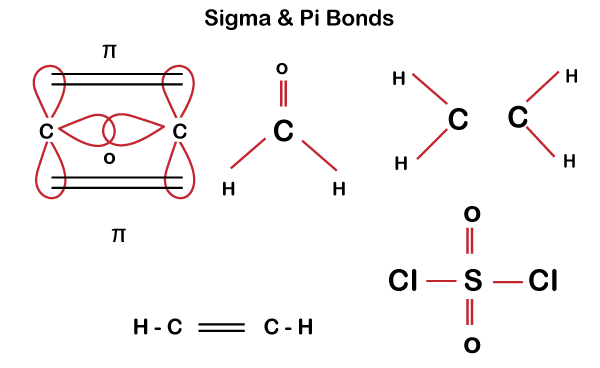
The two carbon atoms in ethene, a hydrocarbon with the chemical formula C2H4, are joined by a double bond. One sigma bond and one pi bond combine to form the double bond. The pi bond is created by the sideways overlapping of two p orbitals perpendicular to the molecule's axis. In contrast, the sigma bond is created by overlapping two sp2 hybridized atomic orbitals.
The two carbon atoms in acetylene, a molecule with the chemical formula C2H2, are connected by a triple bond. One sigma bond and two pi bonds combine to form the triple bond. The two pi bonds are created by the sideways overlapping of two sets of unhybridized p orbitals perpendicular to the molecule's axis. In contrast, the sigma bond is created by overlapping two sp hybridized atomic orbitals.
With the chemical formula C6H6, the cyclic hydrocarbon benzene contains six carbon atoms organized in a hexagonal ring. Sigma bonds connect each carbon atom to two other carbon atoms and two hydrogen atoms through extra sigma bonds. Three pi bonds, created when the p orbitals of adjacent carbon atoms overlap sideways, further stabilize the bonding between the carbon atoms. Overall, the sigma and pi bond examples in organic molecules show how versatile and significant these bonds are in deciding the chemical and physical properties of molecules. Sigma and Pi Bonds Function in Molecular GeometrySigma and pi links impact a molecule's molecular geometry, or how the atoms are arranged in three dimensions. Placing a molecule's nuclei and the electron pairs that orbit them define its shape. Atoms in sigma bonds are aligned along the axis between them and joined by the head-on overlap of their atomic orbitals. Thus, sigma bonds help explain why molecules have linear, trigonal planar, tetrahedral, and other shapes. While pi bonds produce an area of electron density above and below the bonding axis, they are created by the sideways overlap of two parallel p orbitals. Pi bonds usually occur in double and triple bonds, and they help to explain why molecules have planar and curved geometries. Sigma and pi bonds can result in particular molecular shapes. For instance, triple-bond molecules like acetylene (C2H2) have a linear structure because they contain two sigma bonds and one pi bond. A molecule's geometry is also impacted by the quality and durability of its bonds. Molecules with multiple bonds typically have a shorter bond length and a stronger bond than those with only single bonds because the strength of a sigma bond is typically higher than that of a pi bond. Therefore, sigma and pi bonds are crucial in determining a molecule's molecular geometry, impacting the molecule's characteristics and behavior. Sigma and Pi Bonds Chemical and Reactive CharacteristicsSigma and pi links impact a molecule's reactivity and chemical characteristics. Sigma bonds are more impervious to chemical reactions than pi bonds because they are typically stronger. Also, sigma bonds are more directional, increasing their propensity to participate in chemical processes along the bond plane. Pi bonds are more likely to undergo chemical processes because they are weaker than sigma bonds. They can participate in chemical processes perpendicular to the bond axis because they are less directional. 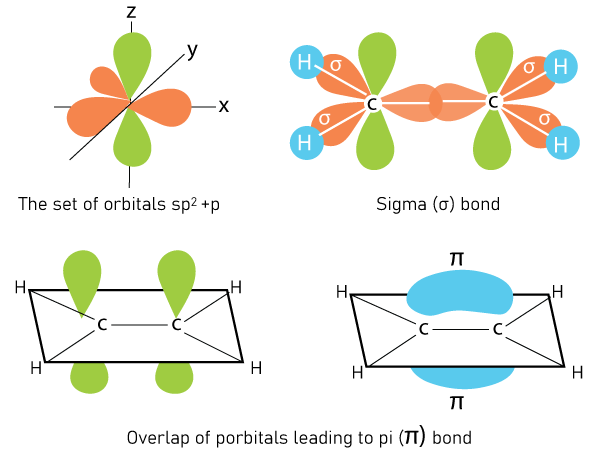
Additionally, the electron density dispersion in sigma and pi bonds influences a molecule's reactivity and chemical characteristics. Sigma bonds are more attractive to electrophiles (electron-deficient species) in chemical reactions because they have a greater electron density in the bonding region between the nuclei. Contrarily, pi bonds are more enticing to nucleophiles (electron-rich species) in chemical reactions due to their greater electron density above and below the bond axis. A molecule's reactivity and chemical characteristics can also be affected by the presence of numerous sigma and pi bonds in that molecule. As an illustration, compounds with two or three bonds are more reactive than those with just one. This is because the molecule is more vulnerable to electrophilic or nucleophilic attacks due to the area of high electron density created by the multiple bonds. In conclusion, the intensity and electron density distribution of a molecule's sigma and pi bonds impact its reactivity and chemical characteristics. Multiple links can also improve a molecule's reactivity by generating an area of high electron density. Examples of Sigma and Pi Bond Applications in Biology and IndustryNatural and commercial settings benefit from using sigma and pi bonds. Applications in Biology
Uses in Industry
Overall, the formation and stability of biological molecules and the development of commercial materials and processes depend heavily on sigma and pi bonds. Limitations and Future DirectionsDespite the depth of our knowledge of sigma and pi bonds, there are still gaps and unexplored possibilities. One drawback is the challenge of directly witnessing the very small-scale formation and characteristics of individual sigma and pi bonds. Researchers frequently use theoretical models and computational techniques to comprehend these bonds' behavior. Another drawback is the need for more knowledge of the behavior of the sigma and pi bonds in circumstances of high pressure and high temperature. Investigating how these bonds behave under these circumstances may reveal new information about their characteristics and possible uses.
Next TopicDifference between
|
 For Videos Join Our Youtube Channel: Join Now
For Videos Join Our Youtube Channel: Join Now
Feedback
- Send your Feedback to [email protected]
Help Others, Please Share










